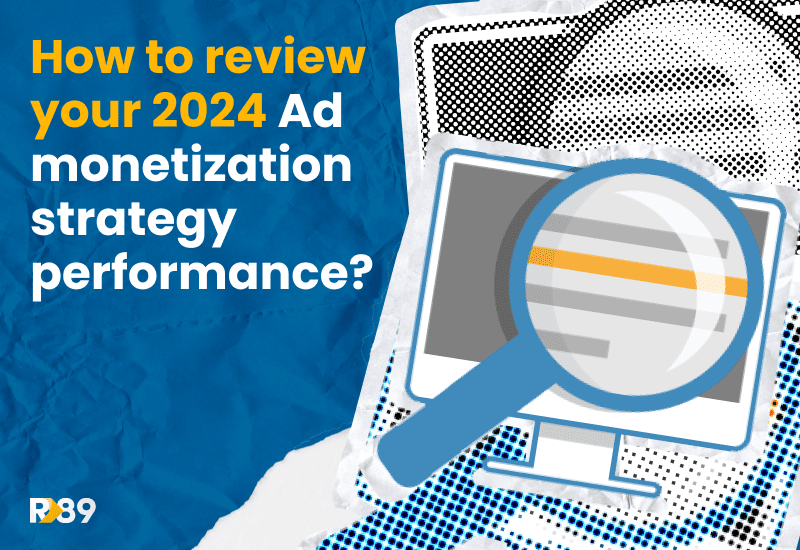New year, new me-trics! But before you dive headfirst into a new chapter for your website’s ad monetization, you need to pick up where you left off 2024 and see if all your hard work paid off. Analyzing your website’s past ad monetization performance will help you improve your ad strategy to start the year on the right foot and have a funtastic 2025! But how exactly do you do it? Keep calm and just continue reading!
What determines ad monetization success for a Publisher?
As in any other discipline, the way to tell if you succeed in your efforts is through metrics (sorry math haters). With your website’s insights, you can check if you managed to meet your goals and how your website is performing against benchmarks. Keep in mind that everyone has different goals, so your own success will be determined by whether you met the expectations you had for your website’s ad monetization.
Let’s quickly go over some of the most valuable metrics that can determine a Publisher’s ad monetization success:
Total Ad Revenue: The total money you make from your ads (fan favorite insight for Publishers 😉)
Impressions: The number of times your ads have been viewed by a user.
RPM: Your revenue per mille. It is the total ad revenue you get per 1000 monetizable page views.
CPM: The cost per mille shows you how much an advertiser pays per one thousand impressions.
Fill rate: It’s the percentage of ads served on your website.
CTR (Click-Through Rate): The percentage of people who clicked on your ad. This metric helps in understanding if an ad was interesting enough to interact with.
Page views: The total number of pages that have been viewed on a website.
Review you ad monetization strategy performance
Check the ad revenue you made last year
Compare total ad revenue from 2024 against previous years. Break down this revenue by different sources (programmatic ads, direct deals, affiliates, etc.) to pinpoint what brings the most coins to your piggy bank. This way you’ll know which sources you should prioritize more in the future, which can use an improvement, or which need to be kicked out of the picture.
Examine your Ad Placement and User Engagement
Ad placement and user engagement play big roles in your ad monetization strategy. Good ad placement ensures your ad units are located in places where they can generate a decent ad viewability rate, while user engagement contributes to getting more website traffic and ad impressions.
Check user engagement metrics such as the bounce rate, average session duration, and pageviews. Also, double check your Core Web Vitals on Google Search Console to make sure you are giving a top-notch user experience to your visitors.
Another way to get deeper insights is by using product-experience insight tools such as Hotjar o Microsoft’s Clarity to analyze heat maps and scroll maps to ensure your ads are positioned in places where they are highly viewable and therefore are more profitable.
Want to know if your ads are properly placed and optimized? Contact our AdOps team and they’ll take a look at your site!
Check your AdTech Partner Performance
Review performance for all your demand partners to ensure they are adding value to your ad stack. Besides revenue, look at metrics such as bid rates, bid CPM, win rate, timeout rate, bids below floor, fill rate, RPM and ad quality for your website while ensuring transparency. This way you should be able to make an objective evaluation of your stack and possible changes in its design. Of course, remember that you are the customer for the demand partners so they should be giving you the best care! 😉
Review Seasonality Trends
Results fluctuate a lot during the year for a Publisher. For example, you’ll notice that CPMs are lower during the first Q vs the last Q of the year. This is because the amount of advertising demand is not the same all year round. It is completely normal and nothing to lose your head over. What you can do is identify the strongest and weakest months throughout the year and plan your ad monetization strategies based on the patterns you find. Make sure to list their causes (holiday seasons, market changes, unexpected news, etc.) and define how you can tackle each situation in the future to maximize your ad results.
What tools can you use to evaluate your website’s ad monetization results
You can use ad management solutions to review your ad monetization results. If you are a Refinery89 Publisher, you can use our Publisher Dashboard! It gives you the most valuable metrics for a Publisher, like your revenue, right off the bat. Here you can check in just one glance your earnings, CPM, RPM, and page views. Want to be part of the #1 Publisher Network in Europe and Latam, contact us to join the gang!
Another tool that comes in handy for staying in the loop with variables that affect your ad monetization strategy is Google Analytics. It’s used to review the traffic and engagement insights from your website. With it you can check the number of sessions, bounce rate, the average engagement time, and more! It might seem overwhelming at first, but you can read this article to untangle some doubts you may have about it.
How to have an even better 2025 in terms of ad revenue?
So, did you meet your ad monetization goals from 2024? Did you improve your metrics or make more revenue? Whatever your outcome was, you are now equipped with many new insights to finely tune your 2025 website’s monetization strategy.
And you know what? You don’t have to be alone in this! We can tag along to give you a hand whenever you need! Pónte en contacto con nosotros en Refinery89 and we’ll help you optimize your website from top to bottom to improve your results. Let’s work together for a terrific 2025!








